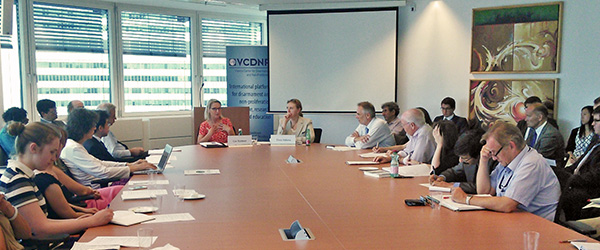

On 11 June 2014, the Vienna Center for Disarmament and Non-Proliferation (VCDNP) hosted a seminar by Dr. Gro Nystuen, senior partner at the International Law and Policy Institute in Oslo, titled "Nuclear Weapons Under International Law." VCDNP Executive Director Elena Sokova moderated the event.
Dr. Nystuen began the discussion with reference to the 1996 International Court of Justice (ICJ) Advisory Opinion on nuclear weapons, which states that the use or threat of nuclear weapons generally represents a violation of international law applicable in armed conflict and the rules of humanitarian law. She argued, however, that the "Court could not reach a definitive conclusion as to the legality or illegality of the use of nuclear weapons by a state in an extreme circumstance of self-defense, in which its very survival would be at stake." Therefore, Dr. Nystuen finds the 1996 ICJ decision to be very ambiguous.
In attempt to clarify the decision of the 1996 ICJ Advisory Opinion and to fill the gap concerning the place of nuclear weapons in international law, Dr. Nystuen presented the key findings of the forthcoming publication titled "Nuclear Weapons Under International Law." The book features well-known experts who critically review the role of international law in governing nuclear weapons. The book moves away from the political context of nuclear weapons and discusses instead the lex lata (the law as it exists) and as it would be interpreted by a judge in a competent court.
The book is divided into seven parts. The first section covers jus ad bellum, the criteria under which a state can legally use force against another state, such as in self-defense or with a UN Security Council authorization. Dr. Nystuen further distinguished this from principles of jus in bello, which refer to the laws that apply during armed conflicts. In this context, Dr. Nystuen debated the relationship between these two concepts in light of the ambiguous ICJ advisory opinion, which does not clearly differentiate between the two.
The second section of the book centers on international humanitarian law. Dr. Nystuen stated that important concepts applicable to nuclear weapons include the rule of distinction between military personnel and civilians, the proportionality of the use of nuclear weapons, and the rule against unnecessary suffering. Part two raises the question of whether or not an attack could be carried out with less harmful means.
Part three focuses on international criminal law, which also includes issues related to liability with regard to both the use and supply of nuclear weapons. One chapter is dedicated to the use of nuclear weapons as an international crime and the Rome Statute of the International Criminal Court (ICC). The key finding of this chapter is that the ICC statue does not prohibit specific types of weapons and, therefore, the ICC does not have jurisdiction in cases regarding the use of nuclear weapons. However, most national courts have jurisdiction and are always the first instances to try such cases dealing with nuclear weapons use.

Part four discusses different aspects of international environmental law and explores varying environmental approaches related to the use of nuclear weapons and the protection of the environment from damage during an armed conflict. For example, this section examines the legality of nuclear weapon testing under international law. There has been an ongoing discussion whether the Comprehensive Nuclear-Test-Ban Treaty represents customary law. Dr. Nystuen argued that most law experts would agree that testing related to atmospheric tests could be considered customary law, but there seems to be a lack of consensus regarding the legality of underground tests. This section further looks at other environmental law treaties that do not deal with nuclear weapons, as such, but rather with environmental damage, raising the question of whether or not such treaties concerning environmental damage would continue to apply during an armed conflict.
Section five considers international disarmament law, including nuclear-weapon-free zone (NWFZ) treaties and the Treaty on the Non-Proliferation of Nuclear Weapons (NPT). In addition to analyzing the basic frameworks of NWFZs and the history of the NPT negotiations, in particular Article VI, this section also discusses nuclear terrorism and UN Security Council Resolution 1540.
Part six is dedicated to international human rights law, focusing on the applicability of human rights with regard to nuclear weapons, such as the right to life and health. Other rights discussed in this section are the right to remedy and reparation in light of a nuclear weapon detonation whether by intentional use, accident, or testing.
The last chapter summarizes the current status of nuclear weapons under international law. Dr. Nystuen concluded that "international law, as such, will not solve the issue of nuclear weapons," and that there is an evident gap in international law on this subject.
The forthcoming book is timely in light of recent attention given to the humanitarian consequences of nuclear weapons and the recent Marshall Islands lawsuit at the ICJ filed against all nine nuclear weapon state possessors.
By continuing to use the site, you agree to the use of cookies. more information
The cookie settings on this website are set to "allow cookies" to give you the best browsing experience possible. If you continue to use this website without changing your cookie settings or you click "Accept" below then you are consenting to this.